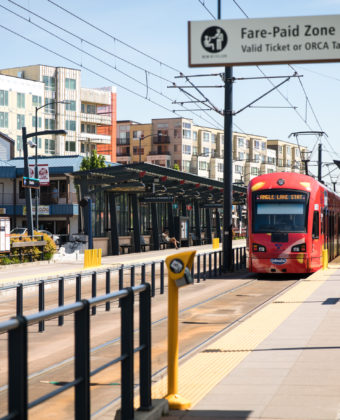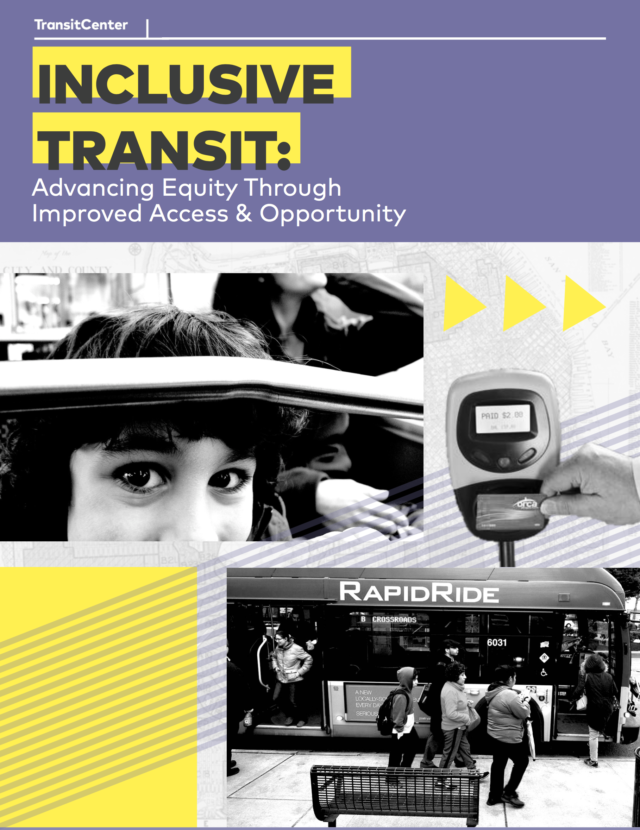Introduction
At its best, public transit provides safe, affordable, and convenient access to the places that allow people to lead healthy, fulfilling lives. Every day, buses, trains, paratransit, and other transit modes connect millions of people to jobs, education, health care, goods and services, friends and family, and other essentials.
But millions of riders also encounter inequities in transit systems. These include disparities between transit and car-based travel, which has been prioritized at all levels of government policy to the detriment of transit. They also include disparities within transit systems, such as fare structures that make good service unaffordable to people with low incomes, policing that brutalizes and discriminates against Black and brown riders, safety concerns that are felt more strongly by women and LGBTQ people, and infrastructure that is inaccessible to people with disabilities.
Many of these inequities can be traced to racial discrimination in mid-20th century planning. In large urban regions, patterns of mass suburbanization produced expensive rail services that whisked affluent, white commuters through the neighborhoods of Black and brown people. Meanwhile, the disproportionately Black and brown residents who remained in central cities were served by affordable but unreliable local transit networks. Today, federal civil rights protections prevent some policies that would obviously worsen racial and social inequities. But even under “neutral” policies, the effects of past discrimination persist, maintaining disparities embedded in the system.
This report addresses the persistent inequities within transit. We examine how current practices in the field of transit can marginalize groups of people — including Black, Indigenous, and people of color, people with low incomes, people with disabilities, women, and LGBTQ people. And we explore how some agencies are changing these practices, confronting racism and discrimination in their own decisionmaking, and establishing new protocols to prioritize riders who have historically been neglected.
Many transit practitioners are working toward change, but face institutional barriers to industry-wide transformation. The main federal mechanism of transit equity oversight, the FTA’s implementation of Title VI of the Civil Rights Act of 1964, focuses narrowly on preventing system changes that worsen social disparities While Title VI guards against some inequities, harmful policies can (and do) slip past its blunt approach. And it is fundamentally reactive: designed to prevent the worst but not to motivate anything better.
At many transit agencies, lack of leadership attention and lack of representation stymie internal progress on equity. While 60% of U.S. transit riders identify as people of color, two-thirds of agency staff and leadership roles are filled by white people. The number of people riding influences how boards set agendas and how governments disburse grant money. And so financial or political pressures may dampen transit agency efforts to preserve equity, which can run counter to increasing ridership or revenue.
Transit agencies must elevate equity as a principle that governs every decision, then commit to operationalizing equity in the day-to-day practices of management, budgeting, workforce hiring and retention, public engagement, data analysis, policymaking, and service provision. They should acknowledge transit agency practices that, regardless of intention, have marginalized groups of people, then shift power to these people so they can meaningfully shape the transit practices that affect them. By treating equity as a guiding value, transit agencies can repair disparities within their systems and make their services more effective at addressing injustice in the broader transportation network.
This report aims to provide the transit industry with a shared vocabulary to productively discuss issues of equity, and to supply models for operationalizing equity in transit agency practice. It includes:
- A framework for transit agencies to define equity and consider how it should shape their work.
- Recommended actions that transit agency staff and leaders, advocates, and the federal government can take to further transit equity.
- Case studies of transit agency equity initiatives, reviews of software tools that can be used to evaluate equity, and lessons from non-transportation fields.
Research Process / Acknowledgments
This report was written by a team of researchers from TransitCenter and the Center for Neighborhood Technology, including Mary Buchanan, Jessica Cruz, Bob Dean, Jacky Grimshaw, Steven Higashide, Heidy Persaud, Natalee Rivera, and Preeti Shankar. David Bragdon, Ben Fried, Stephanie Lotshaw, Tom Pera, and Chris Van Eyken provided additional writing and editorial review.
The findings and synthesis draw considerably upon the experience of our Project Advisory Committee. Committee members met with the project team five times over the course of the research in 2020 and 2021. They helped shape the project direction, participated in some case study interviews, reviewed draft findings and text, and provided much-valued counsel throughout the process. Committee members included:
- Dara Baldwin, Center for Disability Rights
- Jonathan Brooks, LINK Houston
- Hana Creger, Greenlining Institute
- Naomi Doerner, Nelson/Nygaard
- Cyndi Harper, Metro Transit
- Lisa Jacobson, Barr Foundation
- Jarred Johnson, TransitMatters
- Alex Karner, University of Texas at Austin
- Nadine Lee, Dallas Area Rapid Transit (formerly Los Angeles Metro)
- Erik Llewellyn, Pace Suburban Bus
- Briana Lovell, City of Seattle
- Adonia Lugo, Antioch University
- Laurel Paget-Seekins, Open Society Foundations (formerly Massachusetts Bay Transportation Authority)
- Axel Santana, PolicyLink
- Anson Stewart, Conveyal / MIT Transit Lab
We began by reviewing roughly 70 equity plans, frameworks, and related research papers from public agencies, civic organizations, and academia (these are available in an appendix as the “Annotated Bibliography.”) The project team identified common themes, then refined them after discussion with the Project Advisory Committee; the resulting themes are described in the “Defining an Equity Strategy” section.
Next, the project team interviewed 45 transportation agency staff, advocates, private-sector consultants, and practitioners in non-transportation fields to develop case study reports on equity practices at agencies and government, in advocacy, and in evaluation and research. Advisory Committee members joined some of these interviews, and provided extensive feedback on the findings. We are grateful to the interviewees (named in the case studies and in Appendix II) for sharing their time and expertise.
Finally, the project team processed the results of the industry-wide scan, the case studies, and notes from advisory committee meetings. We synthesized this body of research into findings that can be applied by transit staff and decision makers to operationalize equity.
Notes on Terminology
- Marginalization: describes the historic and current systemic exclusion or oppression that individuals and communities face as a result of racism, classism, ableism, sexism, and other forms of discrimination embedded in institutions.
- People who have been marginalized: describes people facing systemic exclusion or oppression, because of aspects of their identity. Black, Hispanic, Asian, and Indigenous people; immigrants; people with low incomes; people with disabilities; LGBTQ people, women, and other groups often face marginalization in communities across the United States. In transportation, practitioners have enacted discriminatory policies that prevent some people from having affordable, safe, and convenient transportation.
- Equity: is a principle that recognizes how an institution or system harms certain groups of people with excessive burdens and deprives them of the benefits of that system, and corrects that imbalance by committing more resources to and by heavily weighing the needs and influence of marginalized groups when considering policy.
- BIPOC: stands for Black, Indigenous, and People of Color and refers to members of specific racial and ethnic groups who have faced historic and ongoing marginalization in the United States.
- Community-based organizations: are organizations focused on advocacy, community organizing, and/or direct service provision for a specific community or small set of communities. CBOs are distinct from regional-scale advocacy organizations, which also play roles in advancing equity.

